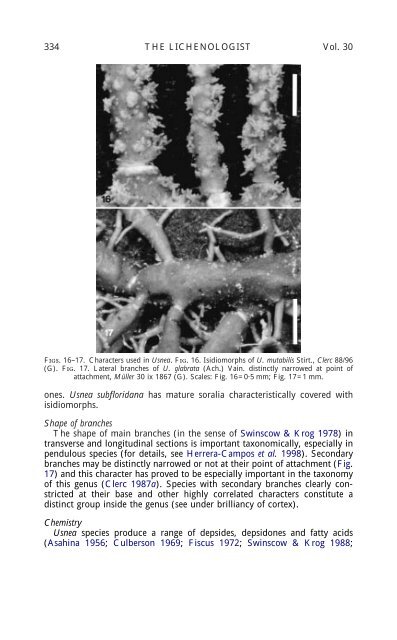SPECIES CONCEPTS IN THE GENUS USNEA (LICHENIZED ...
SPECIES CONCEPTS IN THE GENUS USNEA (LICHENIZED ...
SPECIES CONCEPTS IN THE GENUS USNEA (LICHENIZED ...
Create successful ePaper yourself
Turn your PDF publications into a flip-book with our unique Google optimized e-Paper software.
334 <strong>THE</strong> LICHENOLOGIST Vol. 30<br />
Figs. 16–17. Characters used in Usnea. Fig. 16. Isidiomorphs of U. mutabilis Stirt., Clerc 88/96<br />
(G). Fig. 17. Lateral branches of U. glabrata (Ach.) Vain. distinctly narrowed at point of<br />
attachment, Müller 30 ix 1867 (G). Scales: Fig. 16=0·5 mm; Fig. 17=1 mm.<br />
ones. Usnea subfloridana has mature soralia characteristically covered with<br />
isidiomorphs.<br />
Shape of branches<br />
The shape of main branches (in the sense of Swinscow & Krog 1978) in<br />
transverse and longitudinal sections is important taxonomically, especially in<br />
pendulous species (for details, see Herrera-Campos et al. 1998). Secondary<br />
branches may be distinctly narrowed or not at their point of attachment (Fig.<br />
17) and this character has proved to be especially important in the taxonomy<br />
of this genus (Clerc 1987a). Species with secondary branches clearly constricted<br />
at their base and other highly correlated characters constitute a<br />
distinct group inside the genus (see under brilliancy of cortex).<br />
Chemistry<br />
Usnea species produce a range of depsides, depsidones and fatty acids<br />
(Asahina 1956; Culberson 1969; Fiscus 1972; Swinscow & Krog 1988;

















